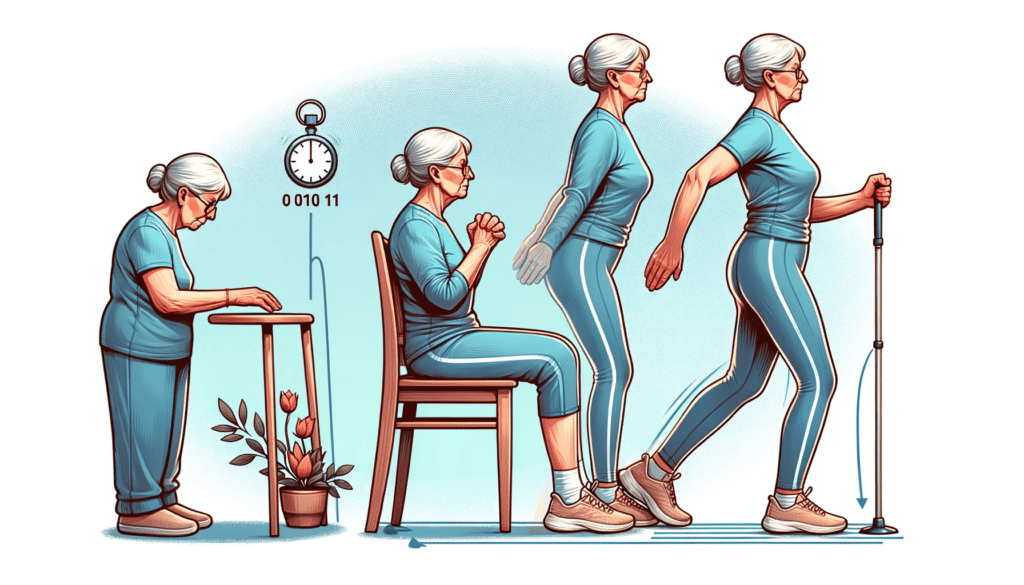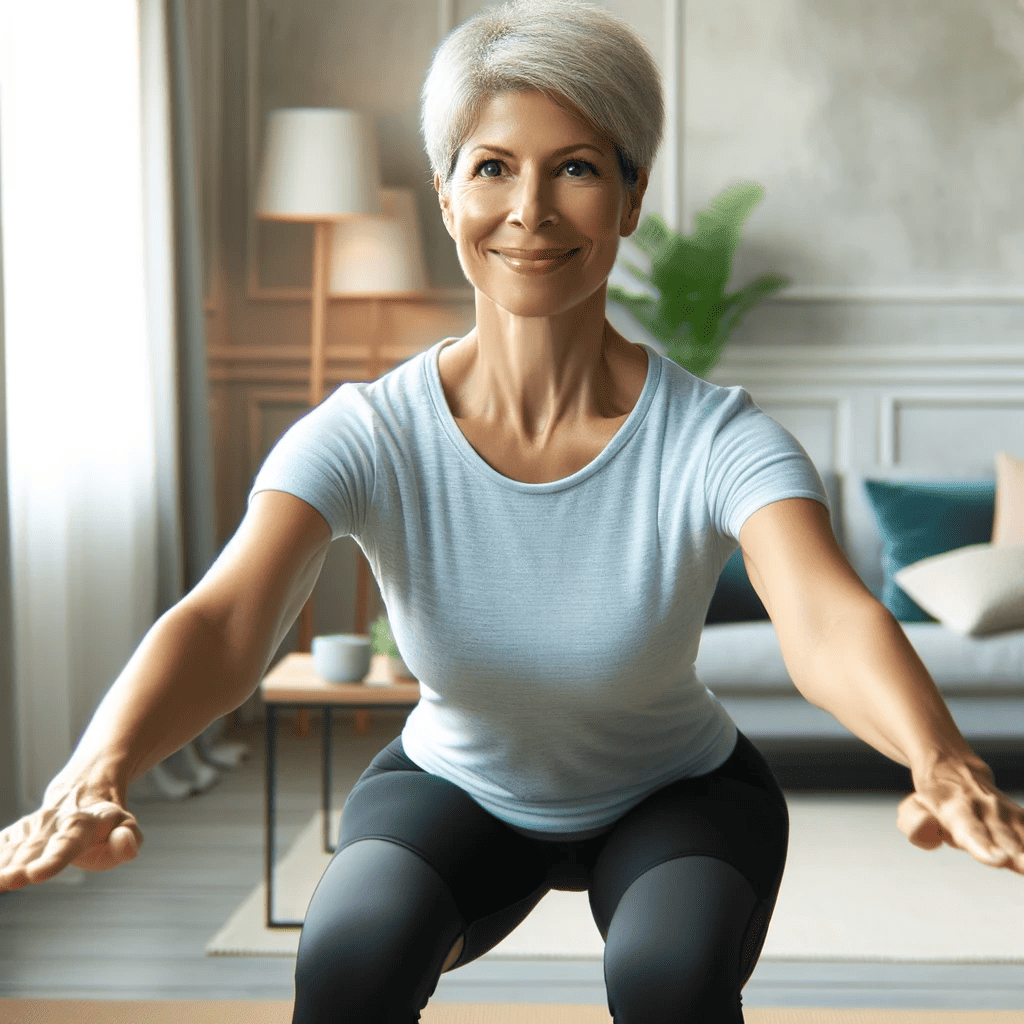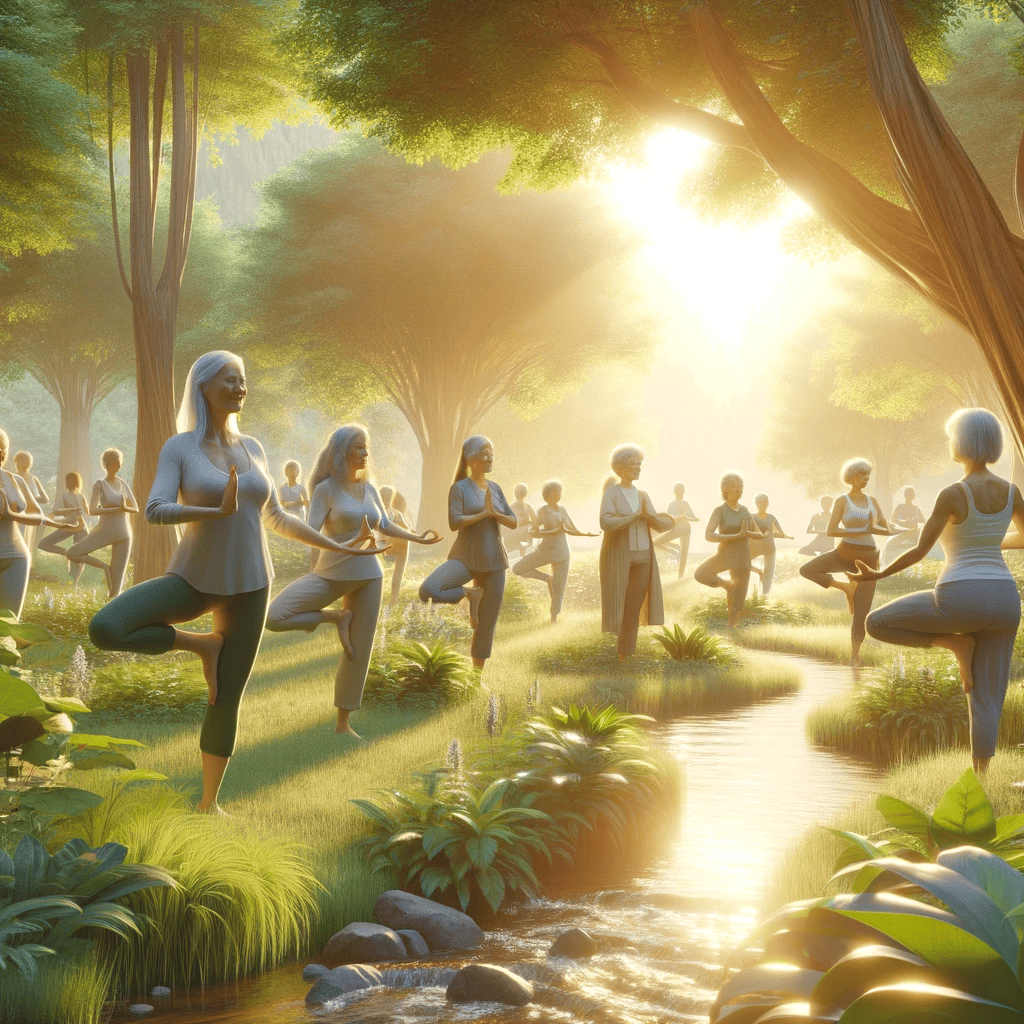Strength and Balance Training for Women Over 50: A Comprehensive Guide to Strength Training and Balance Exercises

Image Source: FreeImages
Introduction
The importance of strength and balance for women over 50 cannot be overstated. As we age, our bodies undergo various changes that can impact our physical capabilities. For women over 50, maintaining strength and balance is not just about staying fit; it’s a crucial aspect of ensuring a high quality of life and independence. This comprehensive guide aims to provide in-depth knowledge and practical advice to help women over this age threshold to not only understand but also effectively manage and improve their strength and balance.
In this guide, we’ll cover a range of topics, each tailored to give you a thorough understanding of the subject. We’ll explore how aging affects physical strength and balance, the critical role of muscle mass and bone density, and common health issues that can impact your physical capabilities. We’ll delve into the benefits of maintaining strength and balance, including improved mobility and reduced risk of falls. Additionally, we will guide you through assessing your current fitness levels, provide a selection of targeted exercises, discuss the role of nutrition, and suggest lifestyle changes to enhance your physical well-being. Lastly, we’ll share inspirational success stories and highlight the importance of professional guidance.
Let’s embark on this journey to empower women over 50 with the knowledge and tools they need to lead a stronger, more balanced, and healthier life.
Understanding the Impact of Aging on Strength and Balance
Aging is an inevitable process that brings about significant changes in our bodies, affecting our physical strength and balance. For women over 50, understanding these changes is the first step towards maintaining and improving their overall fitness.
How Age Affects Physical Strength and Balance
As we age, our bodies experience a natural decline in muscle mass and strength, a condition known as sarcopenia. This decline typically accelerates after the age of 50. Additionally, our neuromuscular system, responsible for coordinating movements and maintaining balance, also undergoes changes. These factors combined can lead to a noticeable decrease in physical strength and balance in women over 50.
The Role of Muscle Mass and Bone Density
Muscle mass and bone density are critical components of physical strength and balance. Muscle mass provides the power needed for movement and daily activities, while bone density is crucial for structural support and injury prevention. Women are particularly susceptible to osteoporosis, a condition where bones become brittle and fragile. The decrease in estrogen levels after menopause significantly impacts bone density, increasing the risk of fractures.
Common Health Issues Affecting Strength and Balance
Women over 50 may face several health issues that can further impact their strength and balance. Conditions such as arthritis, diabetes, and cardiovascular diseases can affect physical abilities. It’s essential to understand these challenges to adopt the right strategies to mitigate their impact.
Maintaining strength and balance offers a multitude of benefits for women over 50, significantly enhancing their quality of life. Let’s delve into these advantages:
Improved Mobility and Independence
One of the most significant benefits of maintaining strength and balance is enhanced mobility. Strong muscles and good balance enable women to perform daily activities with ease, from carrying groceries to climbing stairs. This independence is crucial for a fulfilling lifestyle and helps in maintaining a sense of self-reliance.
Reduced Risk of Falls and Injuries
Falls are a leading cause of injury among older adults. By improving balance and muscle strength, the risk of falls dramatically decreases. Stronger muscles provide better support for the joints, reducing the likelihood of injuries. This is particularly important as the healing process tends to slow down with age.
Enhanced Overall Health and Wellness
Maintaining strength and balance contributes to overall health and wellness in several ways. It can lead to better cardiovascular health, improved mental health, and even cognitive benefits. Regular exercise, which is key to maintaining strength and balance, also boosts the immune system and helps in weight management.
These benefits underscore the importance of focusing on strength and balance in your fitness routine.
Assessing Your Current Strength and Balance Levels
To effectively improve your strength and balance, it’s essential to first assess your current fitness levels. This assessment will help you understand your starting point and track progress over time.
Signs of Reduced Strength and Balance
Be on the lookout for certain signs that may indicate reduced strength and balance, such as:
- Difficulty standing up from a seated position
- Challenges in walking or climbing stairs
- Increased clumsiness or frequent stumbling
- A general feeling of instability or unsteadiness
Professional Assessments for Strength and Balance
Seeking professional assessments can provide a detailed understanding of your fitness levels. Healthcare providers, such as physical therapists, can conduct various tests to evaluate your muscle strength, balance, and overall physical function. These assessments might include:
- Gait analysis
- Balance tests (like the Romberg test)
- Muscle strength measurements using specific equipment
Home-Based Tests to Gauge Your Current Fitness Levels
You can also perform simple tests at home to get an idea of your strength and balance:
- Chair Stand Test: Time how long it takes you to stand up and sit down from a chair ten times.
- Balance Test: Try standing on one foot and see how long you can maintain the position without support.
- Walking Test: Measure the time it takes to walk a set distance and note your comfort level and stability.

Understanding your current fitness levels is crucial in tailoring an effective exercise plan.
Exercises to Improve Strength and Balance for Women Over 50
Incorporating regular exercise into your routine is key to enhancing strength and balance. Here are some recommended exercises, complete with images for guidance, and safety tips to ensure effective and injury-free workouts.
Importance of Regular Strength Training and Balance Exercises
Regular physical activity is vital for maintaining muscle mass, improving bone density, and enhancing overall physical and mental health. Aim for at least 150 minutes of moderate aerobic activity or 75 minutes of vigorous activity per week, along with strength training exercises at least twice a week.
Recommended Exercises for Improving Strength
- Squats: Great for leg and core strength. Start by sitting and standing from a chair, then progress to unsupported squats.
- Wall Push-Ups: These strengthen the upper body and are a gentler alternative to traditional push-ups.
- Leg Lifts: Lying on your side, lift each leg to strengthen hip and thigh muscles.

Recommended Balance Exercises for Improving Balance
- Heel-to-Toe Walk: Walk in a straight line with one foot directly in front of the other to improve balance and coordination.
- Standing on One Foot: Hold onto a chair for support and gradually increase the time you stand on one foot.
- Tai Chi or Yoga: These practices improve balance and flexibility through slow, controlled movements.

Safety Tips When Performing Training Exercises
- Warm-Up Properly: Always start your workout session with a light warm-up to prepare your muscles.
- Listen to Your Body: If you feel pain or discomfort, stop the exercise and consult with a healthcare professional.
- Stay Hydrated: Drink plenty of water before, during, and after exercising.
- Use Proper Form: Ensure you’re performing each exercise correctly to avoid injury. Consider working with a trainer initially to learn proper techniques.
These exercises, tailored for women over 50, are designed to enhance strength and balance safely and effectively. Next, we will explore the role of nutrition in maintaining strength and balance, including key nutrients and dietary recommendations.
Role of Nutrition in Maintaining Strength and Balance
Proper nutrition plays a crucial role in maintaining and improving strength and balance for women over 50. Understanding and incorporating the right nutrients into your diet can significantly enhance your physical capabilities.
Key Nutrients for Maintaining and Improving Strength and Balance
- Protein: Essential for muscle repair and growth. Include lean meats, beans, nuts, and dairy in your diet.
- Calcium and Vitamin D: Vital for bone health. Good sources are dairy products, leafy green vegetables, and fortified foods.
- Magnesium: Important for muscle function and bone health. Found in nuts, seeds, whole grains, and leafy green vegetables.
- Omega-3 Fatty Acids: Beneficial for joint health and inflammation reduction. Sources include fatty fish, flaxseeds, and walnuts.
Recommended Diet for Women Over 50
A balanced diet for women over 50 should include:
- A variety of fruits and vegetables for essential vitamins and minerals.
- Whole grains for fiber and energy.
- Lean protein sources for muscle maintenance and repair.
- Limited intake of processed foods and sugars.

The Impact of Hydration on Muscle Strength and Balance
Hydration is often overlooked but is critical for muscle function and overall balance. Dehydration can lead to muscle fatigue and weakness, impacting balance and coordination. Aim to drink at least 8 glasses of water daily, and more if you are physically active.
Incorporating these nutritional guidelines into your daily diet can greatly assist in maintaining and improving your strength and balance. Next, we’ll discuss lifestyle changes that can further boost your physical capabilities, including the importance of sleep, stress management, and regular health check-ups.
Lifestyle Changes to Boost Strength and Balance
Adopting certain lifestyle changes can significantly contribute to improving strength and balance for women over 50. These changes not only enhance physical capabilities but also overall well-being.
The Importance of Getting Enough Sleep
Sleep plays a vital role in physical health. It helps repair and build muscles worked during the day, especially important after exercising. Adults should aim for 7-9 hours of quality sleep per night. Poor sleep can lead to decreased muscle mass and balance issues, making it harder to maintain physical fitness.
Stress Management Techniques To Improve Mental Wellness
Stress management is crucial for overall health and can indirectly impact physical strength and balance. Chronic stress can lead to muscle tension and imbalance, affecting physical performance. Techniques such as meditation, deep breathing exercises, and engaging in hobbies can help manage stress levels.
The Role of Regular Check-Ups and Health Screenings
Regular health check-ups and screenings are essential for women over 50. These appointments can help identify and manage health issues that might affect strength and balance, such as osteoporosis or hormonal imbalances. Early detection and treatment can prevent these conditions from worsening.
Incorporating these lifestyle changes can have a profound impact on maintaining and improving strength and balance. Next, we will explore inspirational success stories of women over 50 who have improved their strength and balance, providing motivation and key takeaways from their experiences.
Success Stories: Women Over 50 Who’ve Improved Their Strength and Balance
Hearing about others’ successes can be incredibly motivating. In this section, we celebrate the achievements of women over 50 who have taken steps to improve their strength and balance, offering inspiration and valuable insights from their journeys.
Inspirational Stories of Women Who’ve Successfully Improved Their Strength and Balance
- Jane’s Journey: At 55, Jane struggled with mobility due to arthritis. By incorporating low-impact strength training and swimming into her routine, she improved her muscle strength and joint flexibility, significantly enhancing her daily life.
I’m Jane, and at 55, my life took a turn I never expected. Arthritis had crept into my life, making every step a challenge. But I wasn’t ready to let it define me. I decided to rewrite my story, one small, determined step at a time.
I started with low-impact strength training. Holding those light weights, I could almost hear my muscles whispering, “We can do this.” It was hard, but every lift, every squat, felt like a victory. I imagined myself as a sculptor, slowly chiseling away at the stone that was my body’s limitations.
Then, I discovered swimming. The water was my sanctuary, a place where my joints could move freely, without the harsh protests of the land. Each stroke was a conversation between me and the water, a negotiation of strength and grace.
Over time, I felt stronger, more in tune with my body. My joints found a new rhythm, less about pain and more about possibility. It’s incredible how the small things, like climbing stairs without wincing or carrying groceries without pausing, felt like monumental achievements.
This journey, my journey, isn’t just about battling arthritis. It’s about rediscovering myself, about finding strength in vulnerability. And in this pool, in this gym, I’m not just surviving; I’m thriving.
- Maria’s Milestone: Maria, 62, experienced a fall that made her realize the importance of balance. She took up yoga and balance-specific exercises, which not only improved her balance but also her confidence and mental well-being.
I’m Maria, and at 62, a simple fall turned out to be a profound wake-up call. That day, as I lay on the ground, a mix of shock and frustration swirling within me, I realized how crucial balance is – not just physically, but in every aspect of life.
Determined to regain my footing in more ways than one, I turned to yoga. The first day I stepped onto the yoga mat, I was a bundle of nerves. Each pose was a challenge, a delicate dance between effort and ease. But as I moved through the asanas, something wonderful began to happen.
With every tree pose, every warrior stance, I felt a little more stable, a little more grounded. It was as if I was relearning how to stand firm, not just on the mat but in life. And then there were the balance-specific exercises, a series of subtle yet powerful movements that trained my body to find its center, to find its peace.
The journey wasn’t just about avoiding falls. It became a journey towards inner strength. My confidence soared, and with it, my mental well-being. Each day, as I balanced a little better, I smiled a little brighter. I was no longer the woman who fell; I was the woman who rose, stronger and more centered than ever.
- Linda’s Leap: After turning 50, Linda noticed her energy levels and strength declining. Determined to make a change, she started a tailored strength training program with a personal trainer and adjusted her diet. Her efforts paid off, leading to improved strength, better bone density, and a more active lifestyle.
I’m Linda, and turning 50 was more than a milestone; it was a wake-up call. My energy was waning, and my strength wasn’t what it used to be. I knew something had to change, and it had to start with me.
I took the plunge and found a personal trainer, someone who understood the whispers and shouts of a body at 50. Together, we crafted a strength training program tailored just for me. Each weight I lifted was a testament to my determination, each repetition a step towards reclaiming my vitality.
But it wasn’t just about the exercise. I also transformed my diet. Out went the processed, easy fixes and in came the nourishing, strength-building foods. It was a challenge, relearning how to eat, but every healthy meal felt like an investment in myself.
The results? They were more than I hoped for. My strength surged, and with it, my energy levels. I felt like I could conquer the world, or at least my little corner of it. And then came the news from my doctor – my bone density had improved significantly. I was not just stronger; I was sturdier, more resilient.
This journey transformed me. It wasn’t just about getting fit; it was about embracing a more active, vibrant lifestyle. At 50, I thought my best years might be behind me. I couldn’t have been more wrong. They were just beginning.
Key Takeaways from Their Journey
- Consistency is Key: Regular exercise and sticking to a routine were crucial in these women’s successes.
- Personalized Approach: Each woman found activities and exercises that worked for her specific needs and preferences.
- Professional Guidance Helps: Seeking advice from fitness and health professionals can significantly enhance results.
- It’s Never Too Late to Start: These stories prove that age shouldn’t be a barrier to improving physical health.
These inspiring stories showcase the positive impact that dedication to physical health can have, regardless of age.
The Role of Professional Guidance
Seeking professional guidance can be a game-changer for women over 50 looking to improve their strength and balance. Let’s explore when and why to seek such help and how it can benefit your fitness journey.
When to Seek Professional Help
- New to Exercise: If you’re starting a new fitness regime, getting professional advice ensures you’re on the right track.
- Existing Health Conditions: For those with health conditions like osteoporosis or arthritis, tailored guidance is crucial.
- After an Injury: If you’re recovering from an injury, a professional can help devise a safe, effective workout plan.
- Hitting a Plateau: If your progress has stalled, a professional can help adjust your routine for continued improvement.

How Physical Therapists and Trainers Can Help
- Tailored Exercise Plans: They can create customized plans that cater to your specific needs, considering your health conditions, fitness level, and goals.
- Proper Technique and Safety: They ensure you’re performing exercises correctly, reducing the risk of injury.
- Motivation and Accountability: Regular sessions with a trainer or therapist can keep you motivated and accountable for your fitness goals.
- Rehabilitation and Recovery: Physical therapists are essential in helping recover and rebuild strength after injuries.
The Importance of Personalized Exercise Plans
A one-size-fits-all approach doesn’t work in fitness, especially for women over 50 with diverse health backgrounds. Personalized plans consider your unique circumstances, allowing for more effective and safe workouts. This personalization is key to making lasting improvements in strength and balance.
In conclusion, professional guidance can significantly enhance your journey to improved strength and balance. As we wrap up this comprehensive guide, remember the importance of strength and balance for your independence and quality of life. We encourage all women over 50 to embark on this journey, keeping in mind the insights and advice shared in this guide.

